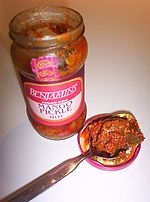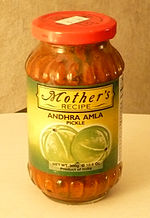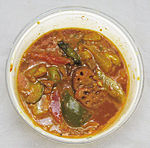- Indian pickle
-

This article is part of the series
Indian cuisineRegional cuisinesNorth India
Main article
Awadhi • Punjabi • Kumauni • Mughlai • Kashmiri • Rajasthani • Uttar PradeshiNorth-East India
Assamese • Meghalayan • Manipuri • Naga • Sikkimese • Tripuri • ArunachaleseSouth India
Main article
Andhra • Karnataka • Kerala • Tamil • Hyderabadi • Udupi • Mangalorean • Saraswat • Mangalorean CatholicEast India
Bengali • Oriya • Bihari • BhojpuriWest India
Goan • Gujarati • Marathi • Malvani & Konkani • Sindhi • ParsiOther
Indian Chinese • Nepali • Jain (Satvika) • Anglo-Indian • Chettinad • Fast foodIngredients and types of foodMain dishes • Desserts • Bread • Drinks • Snacks • Spices • Condiments
See alsoHistory • Etiquette • Indian chefs • Cookbook: Cuisine of India
 India portal
India portalIndian pickles (Hindi: आचार, Urdu: اچار) are made from certain individual varieties of vegetables and fruits that are chopped into small pieces and cooked in edible oils like sesame oil or brine with many different Indian spices like asafetida, red chili powder, turmeric, fenugreek and plenty of salt. Some regions also specialize in pickling meats and fish. Vegetables can also be combined in pickles to make mixed vegetable pickle. Some varieties of fruits and vegetables are small enough to be used whole.
The most common Indian-style pickles are made from mango and lime. Others include cauliflower, carrot, radish, tomato, onion, pumpkin, palm heart, lotus stem, rose petals, ginger, Indian gooseberry, garlic, green or red chili peppers, kohlrabi, gunda (cordia), kerda, zimikand (purple yam), karonda, karela (bitter melon), jackfruit, mushroom, eggplant, cucumber and turnip.
Homemade pickles are prepared in the summer and kept in the sun during daytime while stored in porcelain or glass jars with airtight lids. The high concentrations of salt, oil and spices act as preservatives. Many commercially produced pickles use preservatives like citric acid and sodium benzoate.
Even using the same main ingredients, Indian pickles come in a wide variety of flavors due to differences in spices and process. A mango pickle from South India may taste very different from one made in North India. In the southern states, sesame oil is preferred, while mustard oil is preferred in northern states for making pickles.
Contents
Local names
 Indian Hot Mango pickle
Indian Hot Mango pickle
 A jar of South Indian Andhra amla (Indian gooseberry) pickle
A jar of South Indian Andhra amla (Indian gooseberry) pickle
The term for pickles in Hindi, Urdu, Assamese and Bengali is pronounced as achār, and written in their respective scripts as अचार, اچار, আচাৰ, and আচার.
The Tamil, Telugu and Kannada words for pickles are respectively pronounced as oorugai (ஊறுகாயஂ), Ooragaya (ఊరగాయ), and uppinakaayi (ಉಪ್ಪಿನಕಾಯಿ) in Tulu uppad.
The Malayalam word for pickles is pronounced as 'achaar' or uppillittuthu, each type of pickle being given its own name, such as maanga acharu for mango pickle and ingi acharu for ginger pickle.
The Kannada, Marathi, Konkani and Gujarati words for pickles are respectively pronounced as uppinakayi (ಉಪ್ಪಿನಕಾಯಿ), lonache (लोणचे), and athāṇũ (અથાણું).
The Burmese word for pickle is သနပ် (thanat). Mango pickle (သရက်သီးသနပ်) (thayet thi thanat) is commonly used as a condiment alongside curries and biryani in Burmese cuisine.
Tamil Nadu State has a typical mango pickle, maavadu, which is usually made early in the summer season when mangoes are barely an inch long. The preservation process uses castor oil giving the pickle its unique taste. Another pickle from Tamil Nadu is narthangai consisting of unripe citrons cut into spirals and stuffed with salt.
Tender whole mango pickle is a traditional pickle recipes of Karnataka. This is preserved entirely by dehydrating tender whole mango with salt and is very salty and sour. A special type of this is jeerige midi (ಜೀರಿಗೆ ಮಿಡಿ) prepared using special tender mango with a refreshing aroma.
Raw mangoes, lemon, green chilis, gunda (cordia) and kerda are commonly used as key ingredients in Gujarati cuisine. Varieties of pickled mango commonly found in Gujarati households include salted mango pickle made with groundnut oil and spiced with fenugreek seeds, and red chili powder; hot and sweet mango pickle made with groundnut oil and jaggery, fennel seeds, dry dates (kharek), mustard and red chili powder; and hot and sweet mango pickle made with sugar syrup, cumin and chili powder.
In South Africa, Indian pickles are called atchar, and are sometimes eaten with bread.
See also
- Mixed pickle
- Mango pickle
- Pickling
- Indian cuisine
- Nepalese cuisine
- Chutney
- Curry
- Chakalaka
- Atsara
- Acar
References
External links
Categories:- Bihari cuisine
- Pickles
- Indian condiments
Wikimedia Foundation. 2010.

